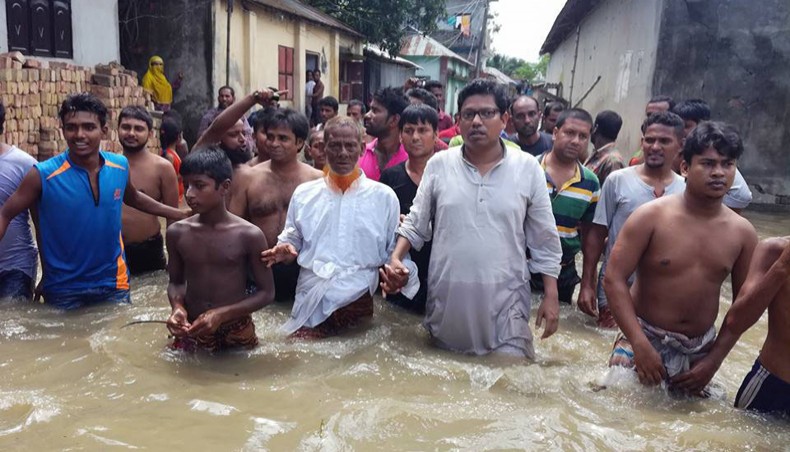Public suffering turns acute
Overall flood situation in the northern districts improved as the water level in all of the major rivers fell further on Tuesday, according to Flood Forecasting and Warning Centre.
As the Ganges-Padma river basin continued falling, the flood-affected districts in the country’s central zones would also improve soon, the FFWC officials hoped.
The death toll from floods in 31 districts rose to 121 on Monday from 115 on Sunday, the disaster management department statistics show.
According to FFWC’s summery report, the Brahmaputra-Jamuna, Padma, Surma and Kushiyara rivers were in the falling trend,
while the Padma was in a slightly rising trend.
The Brahmaputra-Jamuna river system is likely to continue falling in the next 72 hours from Tuesday while the Padma is likely to continue rising slightly in the next 24 hours.
FFWC’s executive engineer Sazzad Hossain told New Age that overall floodwater receded in the Jamuna and the Padma indicating positive trend.
Although rivers surrounding Dhaka swelled slightly, there was no possibility of floods, he assured.
According to updates of the Ministry of Disaster Management and Relief, the number of flood-affected people has increased to 68.99 lakh until Monday.
The fresh floods that hit the north-eastern parts of the country in the second week of the month have already left trails of devastation in Dinajpur, Rangpur, Lalmonirhat, Kurigram, Nilphamari, Jamalpur and Thakurgaon among other districts.
The affected-people are now facing shortage of drinking water, food and medicines due to inadequate relief operations in the worst-affected areas, New Age correspondents in Kurigram, Lalmonirhat and Dinajpur report.
Meanwhile, press release issued by the International Federation of Red Cross and Red Crescent Societies on Tuesday said that fears were rising for hundreds of villages stranded by flood waters in large areas of Nepal, Bangladesh and India.
‘This is the worst flooding that parts of South Asia have seen in decades. Entire communities have been cut off. The only way to get aid to some of these villages is by boat and many are running out of food,’ said Jagan Chapagain, under-secretary general for programmes and operations, International Federation of Red Cross and Red Crescent Societies.
‘The situation is going from bad to worse. In Nepal, as waters finally recede, our teams are finding communities that have lost homes, identity documents – everything. In Bangladesh and India, the number of people affected is rising by the hour as waters rush south.’
Overall, more than 24 million people are believed affected by the flooding in the three countries, with more than 700 people thought dead. Over 1,800 Red Cross and Red Crescent volunteers are working alongside local authorities to prevent further deaths and help communities withstand and recover from the floods.
Clean water and sanitation are major priorities in each of the affected countries with increasing incidents of some diseases already being reported.
‘The floodwaters have become a breeding ground for deadly diseases such as diarrhoea and malaria. We fear that other diseases such as dengue and Japanese encephalitis are also on the rise,’ Chapagain said.
In low-lying Bangladesh, the Red Crescent has described the flooding as some of the worst the country has ever seen.
‘Floodwaters are sweeping from the north of Bangladesh to the centre, submerging whole villages. Many communities are isolated, with no access by land. Millions have been forced to camp on any patch of dry land they can find,’ said BMM Mozharul Huq, Secretary General, Bangladesh Red Crescent Society.
‘We are delivering aid, food, water and other vital supplies but this disaster is one of the biggest we have ever faced. We are appealing for global support,’ Mozharul Huq said.
IFRC is supporting Red Cross and Red Crescent operations in each of the affected countries.
In Nepal, IFRC and Nepal Red Cross are launching a global appeal for about 3.5 million Swiss francs to support 81,000 people living in the most seriously affected parts of the country. IFRC has provided a start-up loan of 500,000 Swiss francs to ensure that resources are immediately available.
In Bangladesh, IFRC and the Bangladesh Red Crescent expect to launch a similarly targeted appeal in the coming days.
In India, IFRC released 320,000 Swiss francs from its Disaster Relief Emergency Fund at the end of July, with a second allocation expected to follow soon.
News Courtesy: www.newagebd.net











